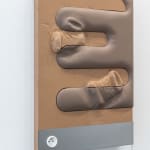Neïl Beloufa
Cans on Brown, 2019
MDF, synthetic leather, steel, electric hardware and electric plug
70 x 50 x 10 cm
27 1/2 x 19 3/4 x 4 inches
27 1/2 x 19 3/4 x 4 inches
Copyright the artist | Courtesy of François Ghebaly, Los Angeles
Photo: Dirk Tacke
Weitere Abbildungen
Neïl Beloufas reliefartige Wandarbeit Cans on Brown (2019) aus der Serie Vintage ist ein Zusammenspiel unterschiedlichster Formen und Materialien. Neben einer sich wölbenden, organischen Lederstruktur, die an eine Hand bzw....
Neïl Beloufas reliefartige Wandarbeit Cans on Brown (2019) aus der Serie Vintage ist ein Zusammenspiel unterschiedlichster Formen und Materialien. Neben einer sich wölbenden, organischen Lederstruktur, die an eine Hand bzw. einen Handschuh denken lässt, sind wie der Titel verrät, zerdrückte Dosen auf einem sandfarbenen Holzgrund arrangiert. Die Dosen sind Zeugnisse der Anwesenheit von Personen und des Konsumverhaltens in einer globalisierten Welt. Nicht nur der Konsum von Waren, auch der mediale Konsum wird hier sichtbar. Unübersehbar in die Edelstahlbasis eingelassen ist eine Steckdose, die Zugang zu Elektrizität gibt und somit im digitalen Zeitalter die Verbindung zu Medien und Dauerverfügbarkeit sicherstellt. So vielschichtig und paradox dies erscheint, dient Beloufas Kunst nicht nur im übertragenen Sinne der Vernetzung, sondern konkret als Einladung, mobile Geräte aktiv an den Stromkreis anzuschließen. Beloufa, der in seinen Arbeiten oft Materialien und Techniken einsetzt, die sichtbare technologische Komponenten beinhalten, stellt auch hier die technischen Aspekte dem auffälligen Materialmix aus Holz, Leder und Metall gegenüber. Die Kombination aus Elektrizität, der grob bearbeiteten Holzoberfläche und dem weichen, geschwungen Leder, erzeugt im wahrsten Sinne ein spannungsgeladenes Relief.
Neïl Beloufa's relief-like wall piece Cans on Brown (2019) from the Vintage series is an interplay of the most diverse forms and materials. In addition to a curving, organic leather structure reminiscent of a hand or glove, there are, as the title suggests, crushed beverage cans arranged on a sand-colored wooden background. The cans are testimonies to the presence of people and our consumer behavior in a globalized world. Not only the consumption of goods, but also media consumption becomes visible here. Conspicuously embedded in the stainless-steel base is a socket that promises access to electricity and thus, in the digital age, the connection to media and permanent availability. As multi-layered and paradoxical as this may seem, Beloufa's art serves not only in the figurative sense of networking, but concretely as an invitation to actively connect mobile devices to the electric circuit. Beloufa, who often uses materials and techniques in his works that contain visible technological components, he juxtaposes the technical aspects with the conspicuous material mix of wood, leather and metal. The combination of electricity, paired with the roughly worked wooden surface and the soft, curved leather, creates a dramatic composition that culminates in the clash of these contrasting materials and, together with the relief-like structure of the boxes, creates a relief that is literally full of tension.
Neïl Beloufa's relief-like wall piece Cans on Brown (2019) from the Vintage series is an interplay of the most diverse forms and materials. In addition to a curving, organic leather structure reminiscent of a hand or glove, there are, as the title suggests, crushed beverage cans arranged on a sand-colored wooden background. The cans are testimonies to the presence of people and our consumer behavior in a globalized world. Not only the consumption of goods, but also media consumption becomes visible here. Conspicuously embedded in the stainless-steel base is a socket that promises access to electricity and thus, in the digital age, the connection to media and permanent availability. As multi-layered and paradoxical as this may seem, Beloufa's art serves not only in the figurative sense of networking, but concretely as an invitation to actively connect mobile devices to the electric circuit. Beloufa, who often uses materials and techniques in his works that contain visible technological components, he juxtaposes the technical aspects with the conspicuous material mix of wood, leather and metal. The combination of electricity, paired with the roughly worked wooden surface and the soft, curved leather, creates a dramatic composition that culminates in the clash of these contrasting materials and, together with the relief-like structure of the boxes, creates a relief that is literally full of tension.







